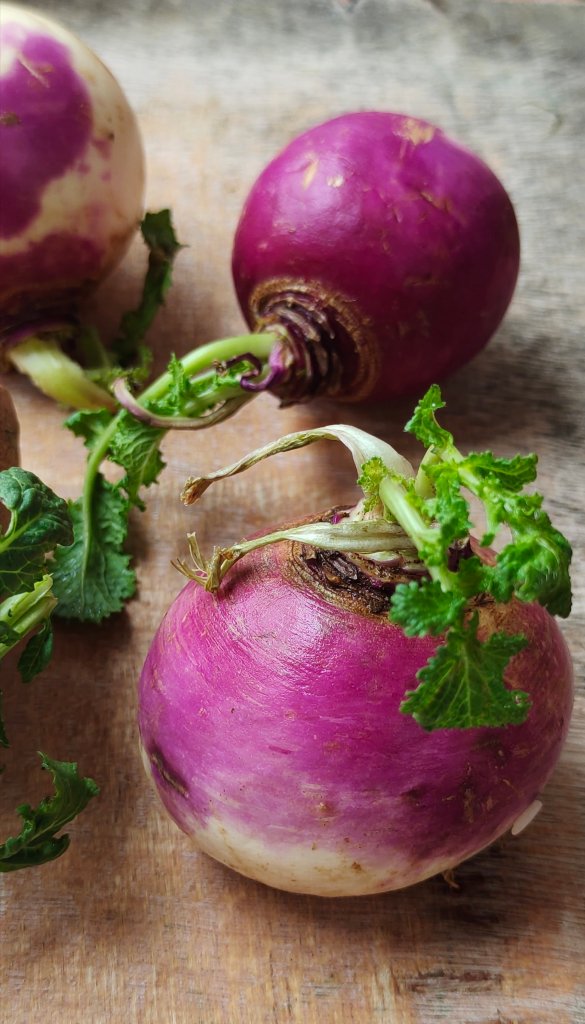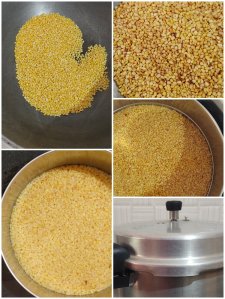A crucial part of Tamilian cuisine, kootu refers to a mildly spiced dish cooked using vegetables and lentils. Kootu is most often made using mixed vegetables or leafy greens, along with moong dal, though there are variations from one family to another. Coconut may or may not be used in kootu, though most commonly it is.
Today, I am sharing our family recipe for Sigappu Keerai Kootu or kootu made using red amaranth greens.

A closer look at Sigappu Keerai Kootu
Like I was saying earlier, this kootu is made using the very nutritious red amaranth greens (called ‘sigappu keerai‘ or ‘sengeerai‘ in Tamil). This recipe uses moong dal and a freshly ground coconut paste, which takes the flavour quotient quite high.
It is made without any onion or garlic and is, hence, suitable for consumption on festivals and other auspicious occasions. It wouldn’t be wrong to term this as a Sattvic dish i.e. food made using fresh, seasonal produce sans refined products, genetically modified ingredients, not overly spiced or fried. Speaking of Sattvic food, I am absolutely loving the many interesting recipes my fellow blogger Poonam has on her blog. Her Achari Aloo post has my heart!
This Sigappu Keerai Kootu is a simple, rustic dish at heart but ultimate comfort food. Pair this kootu with some steaming rice and melted ghee, and it is food nirvana!
If you are considering including more red amaranth in your diet, you should check out this delicious pulav I used it in!
How to make Sigappu Keerai Kootu
Here is how we go about it.
Ingredients (serves 4-6):
1. A big bunch of red amaranth greens (sengeerai or sigappu keerai), about 3 cups when chopped
2. 1/2 cup moong dal
3. 1/2 cup fresh coconut pieces
4. 2 teaspoons cumin seeds
5. 4 dry red chillies or as per taste + 2 more for tempering
6. 1/2 tablespoon + 1/2 tablespoon oil
7. 1 teaspoon mustard seeds
8. 2 pinches of asafoetida
9. Salt to taste
Method:

1. Wash the red amaranth greens thoroughly under running water, to remove any dirt from them. Place in a colander and let all the water drain out. Similarly, wash the moong dal well and drain out all the water from it.
2. Take the washed and drained moong dal in a wide vessel. Add in just enough water to cover the dal. Place the vessel in a pressure cooker. Pressure cook on high flame for 4 whistles or till the moong dal is completely cooked and soft. Let the pressure release naturally.
3. In the meantime, chop the red amaranth greens finely. I had about 3 cups of greens when finely chopped. Keep ready.
4. When the pressure from the cooker has completely gone down, get the cooked moong dal out. Mash the dal thoroughly. Keep it ready.

5. Take the fresh coconut pieces in a small mixer jar. Add in 4 dry red chillies (broken roughly) and the cumin seeds. Grind to a slightly coarse paste, using a little water. Keep aside.
6. Now, heat 1/2 tablespoon oil in a heavy-bottomed pan. Add in the finely chopped red amaranth, along with a bit of salt. Saute for a minute, then add a little water.
7. Cook the red amaranth for 4-5 minutes on medium flame or till it is completely cooked. If the water dries out, add some more.

8. When the greens are cooked through, add in the cooked and mashed moong dal, salt to taste and the ground coconut paste. Also, add about 3/4 cup water or as needed to adjust the consistency of the dish. Keep the flame at medium only. Mix well.
9. Cook everything together on medium flame till it starts bubbling, 3-4 minutes. Reduce the flame further and simmer for a minute more. Switch off gas at this stage.
10. Now, we will prepare the tempering. Heat 1/2 tablespoon oil in a small tempering pan. Add in the mustard seeds and allow them to sputter. Turn down the flame to low and add in the asafoetida and 2 dry red chillies. Let the ingredients stay in for a few seconds, taking care not to burn them. Add this tempering to the greens-lentil mixture we prepared earlier. Cover and keep for a few minutes, then your Sigappu Keerai Kootu is ready to serve. Serve it hot or at room temperature, with rice.
Is this recipe vegan and gluten-free?
This Sigappu Keerai Kootu is completely vegetarian and vegan, suited to those following a plant-based diet.
This recipe is not entirely gluten-free because of the use of asafoetida. Most Indian brands of asafoetida contain some amount of wheat flour, so they are best avoided when one is following a gluten-free diet. If you want to make this dish gluten-free, simply skip the asafoetida used in the tempering here. However, if you can find 100% gluten-free asafoetida, you can definitely go ahead and use it.
Tips & Tricks
1. Any greens can be used in place of the red amaranth I have used here. Use the same proceedure for the other greens.
2. Adjust the quantity of dry red chillies as per personal taste preferences. I have used 4 mildly spiced Bydagi chillies here. This kootu is supposed to be mildly spiced.
3. Adjust the quantity of coconut and moong dal as per personal taste preferences.
4. Some people pressure cook the greens and moong dal together. We saute the greens separately, as we prefer not to overcook them.
5. We don’t usually use turmeric powder in this kootu, but you may if you prefer it.
6. A little urad dal and a sprig of curry leaves can be used in the tempering too. We usually don’t.
7. Adjust the quantity of water you use, depending upon the consistency of the kootu you require.
8. Make sure the moong dal is well cooked, before using it in making the kootu.
9. Keep the Sigappu Keerai Kootu slightly runny. It thickens up after cooking, with time.
Did you like this recipe? Do tell me, in your comments!















